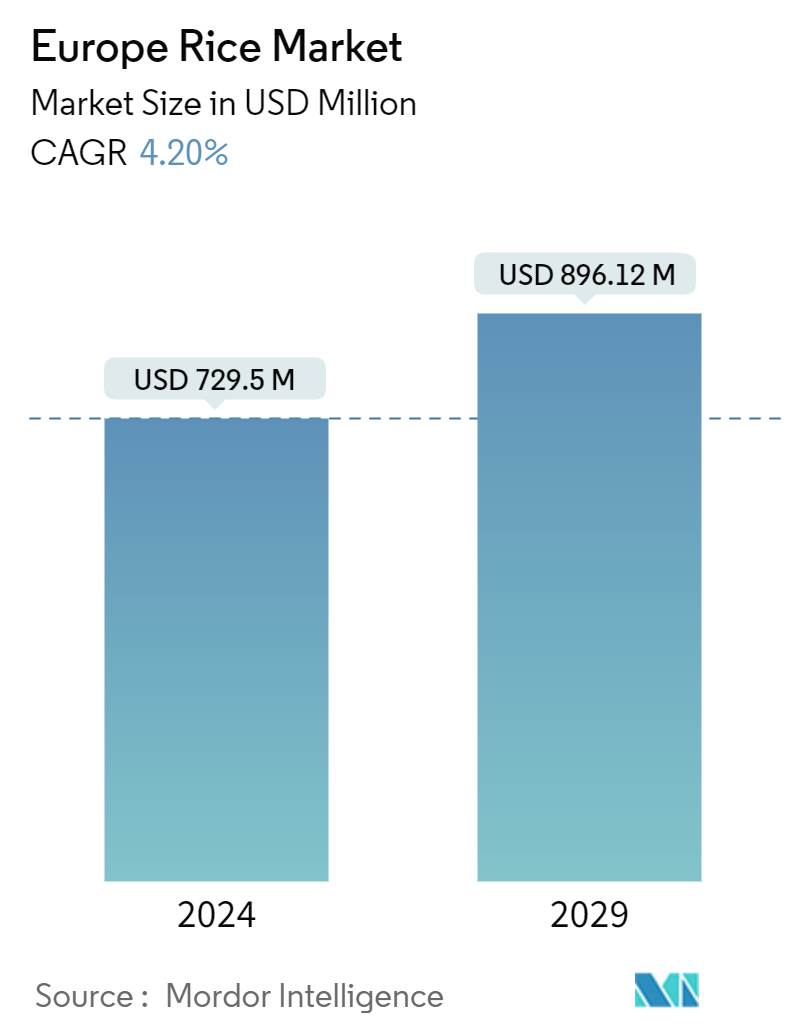Market Size of Europe Rice Industry

| Study Period | 2019 - 2029 |
| Base Year For Estimation | 2023 |
| Forecast Data Period | 2024 - 2029 |
| Market Size (2024) | USD 729.5 Million |
| Market Size (2029) | USD 896.12 Million |
| CAGR (2024 - 2029) | 4.20 % |
Major Players*Disclaimer: Major Players sorted in no particular order |
Europe Rice Market Analysis
The Europe Rice Market size is estimated at USD 729.5 million in 2024, and is expected to reach USD 896.12 million by 2029, growing at a CAGR of 4.20% during the forecast period (2024-2029).
- Europe primarily cultivates round and medium-length rice, known for its stickiness when cooked and classified under the Japonica group. Despite its production, Europe relies on imports to satisfy domestic rice demand, with the United Kingdom, France, Belgium, and Germany being the primary importing nations. In 2022, the region produced 3 million metric ton of rice across 531,925 ha, as reported by the FAOSTAT. Simultaneously, the ITC Trade Map data indicated that the region imported 5.5 million metric tons, positioning Europe as a net importer of rice.
- Europe emphasizes sustainable farming practices and aims to produce high-quality rice for global exports. A testament to this commitment is the European Rice Program, funded by the European Union, which assures consumers of the safety and stringent regulations governing European rice cultivation. This rice is primarily grown in Italy, Portugal, France, and Germany. According to the ITC Trade Map, in 2022, the region exported 2.5 million metric ton of EU rice, with Italy accounting for a significant one-fourth share.
- The region's populace is increasingly favoring specialty rice varieties, mainly basmati rice and brown rice varieties, while shifting away from non-basmati rice consumption. For example, data from the Grain and Feed Trade Association reveals that husked basmati rice, predominantly sourced from India and Pakistan, constitutes 30% of the EU's rice imports. Consequently, the market is propelled by sustainable production initiatives, a surge in basmati rice imports catering to varied consumer preferences, and the export of Japonica rice.
Europe Rice Industry Segmentation
Rice (Oryza sativa) is an edible, starchy cereal grain produced from the grass plant (family Poaceae). For the study, only rice grains have been considered.
The European rice market is segmented by geography (United Kingdom, Germany, France, Italy, Belgium, and Spain). The report covers production (volume), consumption analysis (value and volume), import analysis (value and volume), export analysis (value and volume), and price trend analysis of rice across Europe. The report offers the market size and forecasts for volume (metric ton) and value (USD) for the above segments.
| Geography (Production Analysis by Volume, Consumption Analysis by Volume and Value, Import Analysis by Value and Volume, Export Analysis by Value and Volume, and Price Trend Analysis) | |
| Belgium | |
| United Kingdom | |
| France | |
| Italy | |
| Germany | |
| Spain |
Europe Rice Market Size Summary
The European rice market is characterized by significant production and import activities, with Italy and Spain leading as the primary producers. These countries dominate the rice production landscape, accounting for a substantial portion of the European Union's output. The Japonica variety is predominantly cultivated in Southern Europe, while the region relies heavily on imports for specialty long-grain Indica rice, such as basmati and jasmine, which are primarily sourced from India and Pakistan. The Netherlands serves as a crucial entry point for rice imports, facilitating the flow of rice from various developing countries into Europe. The demand for aromatic and specialty rice varieties is on the rise, particularly in Northwestern Europe, where countries like the United Kingdom, France, and Germany are the largest importers.
The Italian rice industry is notable for its diverse rice varieties and innovative products catering to changing consumer preferences. Italian consumers are increasingly shifting towards rice and grains due to health consciousness, leading to a rise in rice consumption. Local companies, such as Riso Bello, are adapting to these trends by introducing new products like ready-to-eat risottos. Despite challenges like drought affecting production, Italy remains a key player in the European rice market. The market dynamics are further influenced by international trade agreements and strategic investments, such as Mitsui & Co.'s stake acquisition in Rol-Ryz, highlighting the ongoing evolution and growth potential within the European rice sector.
Europe Rice Market Size - Table of Contents
-
1. MARKET DYNAMICS
-
1.1 Market Overview
-
1.2 Market Drivers
-
1.3 Market Restraints
-
1.4 Value Chain Analysis
-
-
2. MARKET SEGMENTATION
-
2.1 Geography (Production Analysis by Volume, Consumption Analysis by Volume and Value, Import Analysis by Value and Volume, Export Analysis by Value and Volume, and Price Trend Analysis)
-
2.1.1 Belgium
-
2.1.2 United Kingdom
-
2.1.3 France
-
2.1.4 Italy
-
2.1.5 Germany
-
2.1.6 Spain
-
-
Europe Rice Market Size FAQs
How big is the Europe Rice Market?
The Europe Rice Market size is expected to reach USD 729.5 million in 2024 and grow at a CAGR of 4.20% to reach USD 896.12 million by 2029.
What is the current Europe Rice Market size?
In 2024, the Europe Rice Market size is expected to reach USD 729.5 million.

